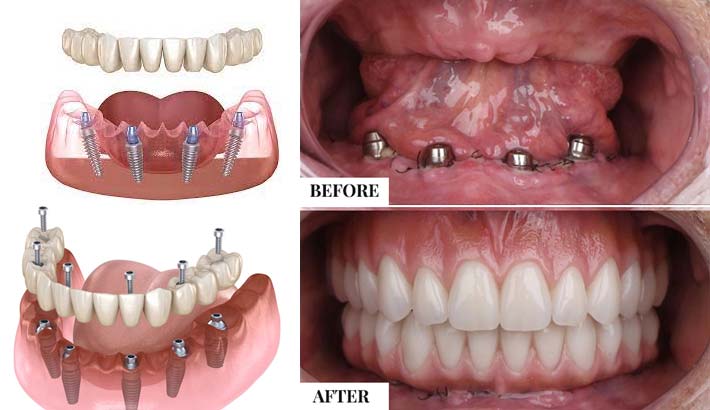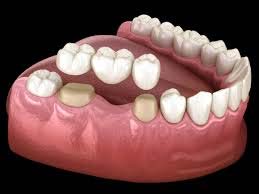Are you looking for a reliable solution to restore your smile? Look no further! Dr. Anirudh Rehani, BDS, MDS (Prosthodontics), offers the best dental implants in Rohini. With his expertise and advanced techniques, you can regain confidence in your smile and enjoy improved oral health.
What are dental implants?

Dental implants are titanium screw that is placed in the jawbone to replace one or more missing teeth. These are a common intervention for tooth loss. There are many reasons for tooth loss, including lack of/poor oral hygiene, plaque and tartar buildup, tooth decay, and gum disease being some of the top reasons. And, on other occasions, certain diseases or accidents(blows, falls, etc.) can cause a tooth to fall out.
Dental implants restore the look and feel of natural teeth while providing a strength and security that other forms of restorative dentistry can’t match.

What are the benefits of dental implants in Rohini
Dental implants offer significant benefits for patients including the following:
- Structural Integrity: By filling in gaps, dental implants not only preserve the original jawbone, but they also reduce the possibility of infections developing. They stop any atrophy of the jawbone.
- Improved Aesthetics: Dental implants will improve the appearance of your smile as well as your jawline and prevent any changes in the shape of your jaw or face that develop with missing teeth.
- Oral Health: Having an implant placed improves your ability and likelihood to brush and floss regularly, which results in improved overall oral health.
- Upgrade from Dentures: Because the titanium post acts like a root, and they are adhered to the jawbone, dental implants are permanent and stable, which will improve your ability to chew foods and talk comfortably.
- Tooth Migration: when a tooth is missing the neighboring teeth immediately begin to shift into the space, affecting your bite alignment.
- Neighboring teeth: Unlike a dental bridge, you are not relying on the neighboring teeth for support. You do not need crowns on them to carry the bridge.
Meet Dr. Anirudh Rehani
Dr. Anirudh Rehani is a renowned prosthodontist with years of experience in restoring smiles with dental implants in Rohini. His commitment to excellence and patient-centered approach make him a trusted choice for individuals seeking quality dental care in Rohini.
Our Comprehensive Approach
At our clinic, we understand that every patient is unique, and we tailor our treatment plans to meet your specific needs and goals. From the initial consultation to the final restoration, Dr. Anirudh Rehani and our dedicated team will guide you through every step of the implant process with care and precision.
State-of-the-Art Facility
We take pride in providing our patients with the highest standard of care in a comfortable and welcoming environment. Our dental clinic in Rohini is equipped with advanced technology and amenities to ensure your experience is as pleasant and stress-free as possible.
Implant placement process
The placement of implants is carried out through a procedure perfected over many years. Therefore, it is a completely safe process. These are the steps that are performed:
Removal of the damaged tooth
To begin the process, local anesthesia is given to the immediate area and the affected tooth is removed and the site is disinfected.
Jaw preparation
On occasion, the patient’s jaw may not be entirely thick or resistant to the action of biting. In such a case, it is necessary to apply a bone graft inside the gum to support the pressure of the implant. This graft can be natural (taken from another area of the patient’s body) or synthetic
Implant placement
To place the implant, an incision is made in the gum, leaving the bone exposed to insert the implant and abutment.
Wait for the bone to grow
It may take several weeks for the implant to fully stabilize in bone.
Crown Placement
In the last step, the custom-made dental crown is attached which can be
- Cemented or fixed crown: It is attached to the implant by means of cement, which makes it impossible to remove it.
- Screw-in or removable crown: It can be removed if necessary.
The choice of one option or another will depend on the needs of the patient and professional advice. For this, it is necessary to have carried out a previous in-depth study.
Are implants safe and how long will they last?
Implants are a safe, well-established treatment. It’s probably true to say that implants, much like natural teeth, will last for as long as you care for them.
How well you look after your implants – and whether you go for your regular maintenance appointments – will have the biggest impact on how long they will last.
If you don’t look after your implants they will develop a coating similar to what you get on neglected natural teeth. Left untreated, this can lead to gum infection, bleeding, soreness and general discomfort. You could get all these problems with natural teeth.
If your implants are well looked after, and if the bone they are fitted to is strong and healthy, you can expect them to last for many years. However, just as with other surgical implants (such as a hip replacement), there is no lifetime guarantee.
I have some of my own teeth. Can I still have implants?

Yes. You can have any number of teeth replaced with implants – from one single tooth to a complete set.
Can implants always be used to replace missing teeth?
It depends on the condition of the bone in your jaw. Your dentist will arrange for a number of special tests to find out the amount of bone still there. If there is not enough, or if it isn’t healthy enough, it may not be possible to place implants without grafting bone into the area first.
Do implants hurt?
Placing an implant is often easier than taking a tooth out and is usually done using a simple local anaesthetic. You will not feel any pain at the time but, just like after an extraction, you may feel some discomfort during the week after the surgery.
Sometimes your dentist in Rohini might give you a sedative if you are very nervous or if the case is a complicated one. General anaesthetics are rarely used for implants and are generally only used for very complicated cases.
How long does the treatment take?
Our team will be able to give you a rough timetable before the treatment starts.
Some false teeth can now even be fitted at the same time as the implants (these are called ‘immediate implants’). Check with us to see whether these are suitable for you. Usually, the false teeth are fitted 2 to 4 months after the implants are put in.
What happens next?
After your implants have been placed, the bone in your jaw needs to grow onto them and fuse to them. This usually takes a few months. Sometimes the implants may be stable enough when they are placed for the false teeth to be fitted sooner than this.
If you are having one, two or three teeth replaced, you may have a temporary denture in the meantime. If you already have full dentures, you can keep wearing these while your implants are healing. Your dentures will need altering, to fit properly after the surgery, and a ‘healing cap’ will usually be placed onto the implant site to protect it.
Are the implant teeth difficult to clean?
No. But aftercare is important if you are going to have a long-lasting, successful implant. Your dental team should give you detailed advice on how to look after your implants. Cleaning around the teeth attached to the implants is no more difficult than cleaning natural teeth. However, there may be areas that are difficult to reach and you’ll be shown how to clean them. You may need to visit your hygienist more often but your dental team will be able to talk to you about this.
If I had gum disease when I had my own teeth, will I get it with the implants?
Yes, if you don’t care for them well enough. If you keep them clean and have them regularly checked by your dental team you should not have any problems. Smoking also affects the health of implants. So, if you smoke, you may need to look after your implants more carefully. Some dentists will not place dental implants in people who are smokers.
Can I take the teeth out if they are fixed to implants?
Most teeth attached to implants can only be fitted and removed by the dentist. However, if you have removable dentures attached to the implants, you’ll be able to take them out for cleaning.
Do the implants show?
Most implants look exactly like natural teeth.
Do I have an implant for each missing tooth?
If you have a single tooth missing, you will need an implant to support it. If you have several teeth missing, and these are next to each other, you could still have one implant for each tooth. Or you may find that, if you have two or more implants, they may be able to support more than one tooth each. Your dentist will talk to you about the best option for you.
What if I have an accident?
Implants and the teeth they support can be damaged by an accident in the same way that natural teeth can. So it is important that you wear a professionally made mouthguard if you play sports that involve contact or moving objects.
You may our information about mouthguards useful. If just the teeth are damaged, they can usually be removed from the implant and replaced.
However, if the titanium implant itself is damaged beyond repair, it can be safely left in the jaw if it is too difficult to remove. Another implant may be fitted alongside it to replace the damaged one.
What happens if the implant does not fuse with the bone?
This happens very rarely. If the implant becomes loose during the healing period, or just after, it is easily removed and your jaw will heal in the normal way. Once your jaw has healed, another implant can be placed there. Or the dentist can make a bridge, fitting it to the implanted false teeth that have been successful.
Proper Care Improves Longevity of Dental Implants
Following the procedure of dental implant in Rohini, it is important to plan on the healing process taking a few weeks. During this time, it will be recommended that you stick to a soft-food diet and gradually reintroduce harder foods as sensitivity and tenderness diminishes. If your implant was placed due to an injury related to sports, it is also important to strongly consider wearing a mouth guard to prevent it happening again.
Once the implant has fully healed, the most important thing to do to preserve the health of the implant is to practice the following oral hygiene habits every day.

Your Journey to a Radiant Smile Begins Here
Don’t let missing teeth hold you back any longer. Schedule a consultation with Dr. Anirudh Rehani today and take the first step towards a healthier, happier smile. With dental implants in Rohini, you can reclaim your confidence and enjoy life to the fullest.











 If you have missing teeth, including front teeth, a dental bridge can help restore the look and function of your teeth. It bridges the gap where the missing tooth is. Talk to a dental professional to find out if it’s right for you.
If you have missing teeth, including front teeth, a dental bridge can help restore the look and function of your teeth. It bridges the gap where the missing tooth is. Talk to a dental professional to find out if it’s right for you.











